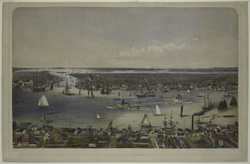The Great Port
 |
| Edgar W. Foreman and Eliphalet M. Brown, Jr. New-York and Environs, from Williamsburgh …. New York, 1848. The Miriam and Ira D. Wallach Division of Art, Prints and Photographs, Print Collection, Eno Collection. Digital ID 54826 |
This entire region was once called Nieuw Nederland, an aspect
of our Dutch heritage and local history that is much forgotten.
Better remembered is the settlement of Nieuw Amsterdam, which
remains at the heart of the great commercial, international, multicultural
City of New York. The founding Dutch investment, settlement, development,
and courage are reflected today in a great living port.
Early in its history, the port of New York was an important outlet
for the fur trade, but later competition from Baltimore, Philadelphia,
and Boston kept a trade balance along the East Coast. The protected
East River provided a shelter for early shipping, and the Hudson
River piers developed rapidly in the 19th century. The Erie Canal
in particular, linking New York to the North American heartland
and its agricultural treasure, invigorated the port, which emerged
as a major export station for wheat, corn, and other produce.
Shipbuilding activity between the War of 1812 and the Civil War
created tens of thousands of jobs, and New York became the largest
shipbuilding center in the world. The China trade in tea, silks,
opium, porcelains, and other items fed the demand for exotic goods.
Hudson River sloops and New York–built clipper ships traveled
to Asia and back. When gold was discovered in California, ships
transported it to New York.
Today the harbor is criss-crossed by tugboats and ferries, barges
and liners, many heading for the newest iteration in trade, the
container port. Local shoreline museums, the South Street Seaport,
the Baykeeper, and the new Harbor District give hope for renewed
knowledge of and relationship with our shoreside environment.